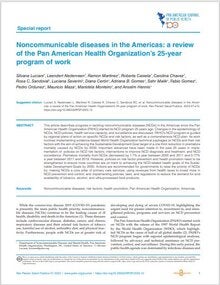[ABSTRACT]. This article describes progress in tackling noncommunicable diseases (NCDs) in the Americas since the Pan American Health Organization (PAHO) started its NCD program 25 years ago. Changes in the epidemiology of NCDs, NCD policies, health service capacity, and surveillance are discussed. PAHO’s NCD program is guided by regional plans of action on specific NCDs and risk factors, as well as a comprehensive NCD plan. Its work involves implementing evidence-based World Health Organization technical packages on NCDs and their risk factors with the aim of achieving the Sustainable Development Goal target of a one third reduction in premature mortality caused by NCDs by 2030. Important advances have been made in the past 25 years in implementation of: policies on NCD risk factors; interventions to improve NCD diagnosis and treatment; and NCD surveillance. Premature mortality from NCDs decreased by 1.7% a year between 2000 and 2011 and 0.77% a year between 2011 and 2019. However, policies on risk factor prevention and health promotion need to be strengthened to ensure more countries are on track to achieving the NCD-related health goals of the Sustainable Development Goals by 2030. Actions are recommended for governments to raise the priority of NCDs by: making NCDs a core pillar of primary care services, using revenues from health taxes to invest more in NCD prevention and control; and implementing policies, laws, and regulations to reduce the demand for and availability of tobacco, alcohol, and ultra-processed food products.
|

